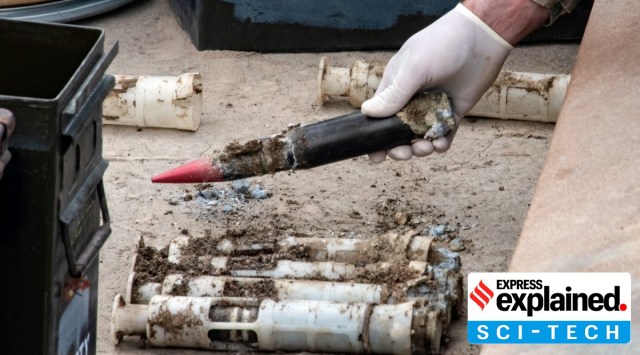UK to provide weapons containing depleted uranium to Ukraine: What are these?
Depleted uranium munitions have been in use for decades and make for a formidable weapon against heavily armoured tanks. Though they aren’t considered nuclear weapons, they emit low levels of radiation and can cause severe diseases.
 In this image provided by the US Air National Guard, US Air Force National Guard Explosive Ordnance Disposal Techinicians prepare several contaminated and compromised depleted uranium rounds on June 23, 2022 at Tooele Army Depot, Utah. (Staff Sgt. Nicholas Perez/US Air National Guard via AP)
In this image provided by the US Air National Guard, US Air Force National Guard Explosive Ordnance Disposal Techinicians prepare several contaminated and compromised depleted uranium rounds on June 23, 2022 at Tooele Army Depot, Utah. (Staff Sgt. Nicholas Perez/US Air National Guard via AP)Just days after the British government said that it would provide Ukraine with armour-piercing rounds containing depleted uranium, Russian President Vladimir Putin Saturday (March 25) announced plans to station tactical nuclear weapons in neighbouring Belarus.
According to Reuters, in his speech on the subject, made on state television, he said, “As to our talks with (Belarus President) Alexander Grigoryevich Lukashenko, the trigger was the statement by the British Deputy Minister of Defenсe that they are going to supply depleted uranium munitions to Ukraine, this is somehow related to nuclear technology. Even outside the context of these events, this statement, Alexander Grigoryevich Lukashenko has long been raising the question of the deployment of Russian tactical nuclear weapons on the territory of Belarus.”
While Putin didn’t mention how many nuclear weapons Russia would keep in Belarus, the US government believes the Kremlin has around 2,000 tactical nuclear weapons, including “bombs that can be carried by tactical aircraft, warheads for short-range missiles and artillery rounds,” Associated Press reported.
The Russian President’s announcement has come after Annabel Goldie, Minister of State for Defence of the United Kingdom, said on March 20 that some of the ammunition for the Challenger 2 battle tanks that Britain is giving to Ukraine includes armour-piercing rounds which contain depleted uranium.
What is depleted uranium?
Depleted uranium is a byproduct of the process of creating enriched uranium, which is used in nuclear reactors and nuclear weapons. In comparison to enriched uranium, depleted uranium is much less radioactive and is incapable of generating a nuclear reaction. However, due to its high density — it’s more dense than lead — depleted uranium is widely used in weapons as it can easily penetrate armour plating.
Speaking to AP, Edward Geist, RAND nuclear expert and policy researcher, said, “It’s so dense and it’s got so much momentum that it just keeps going through the armour — and it heats it up so much that it catches on fire.”
The news outlet also mentioned that the US began manufacturing armour-piercing rounds with depleted uranium in the 1970s and has since added it to composite tank armour to strengthen it.
“It also has added depleted uranium to the munitions fired by the Air Force’s A-10 close air support attack plane, known as the tank killer. The US military is still developing depleted uranium munitions, notably the M829A4 armour-piercing round for the M1A2 Abrams main battle tank”, the report added.
Which countries have depleted uranium munitions?
Apart from the US, Britain, Russia, China, France and Pakistan produce uranium weapons, which are not classified as nuclear weapons, as per the International Coalition to Ban Uranium Weapons, Reuters said. Another 14 states are known to store them, it mentions.
What are the risks of using such weapons?
Even though depleted uranium munitions aren’t considered nuclear weapons, experts suggest that such weapons must be used with caution because they emit low levels of radiation and can cause severe diseases.
“Ingesting or inhaling quantities of uranium – even depleted uranium – is dangerous: it depresses renal function and raises the risk of developing a range of cancers.,” Reuters said. Moreover, according to the International Coalition to Ban Uranium Weapons, depleted uranium munitions which miss their target can poison groundwater and soil.
Where have depleted uranium munitions been used?
Depleted uranium munitions were used in the 1991 Gulf War to destroy T-72 tanks in Iraq. These weapons were again used in the 1999 NATO bombing of Yugoslavia and then during the 2003 invasion of Iraq.
According to the Royal Society, a London-based fellowship of scientists, “About 340 tons of depleted uranium were used in munitions during the 1991 Gulf War, and an estimated 11 tons in the Balkans in the late 1990s,” Reuters reported.
- 01
- 02
- 03
- 04
- 05






































